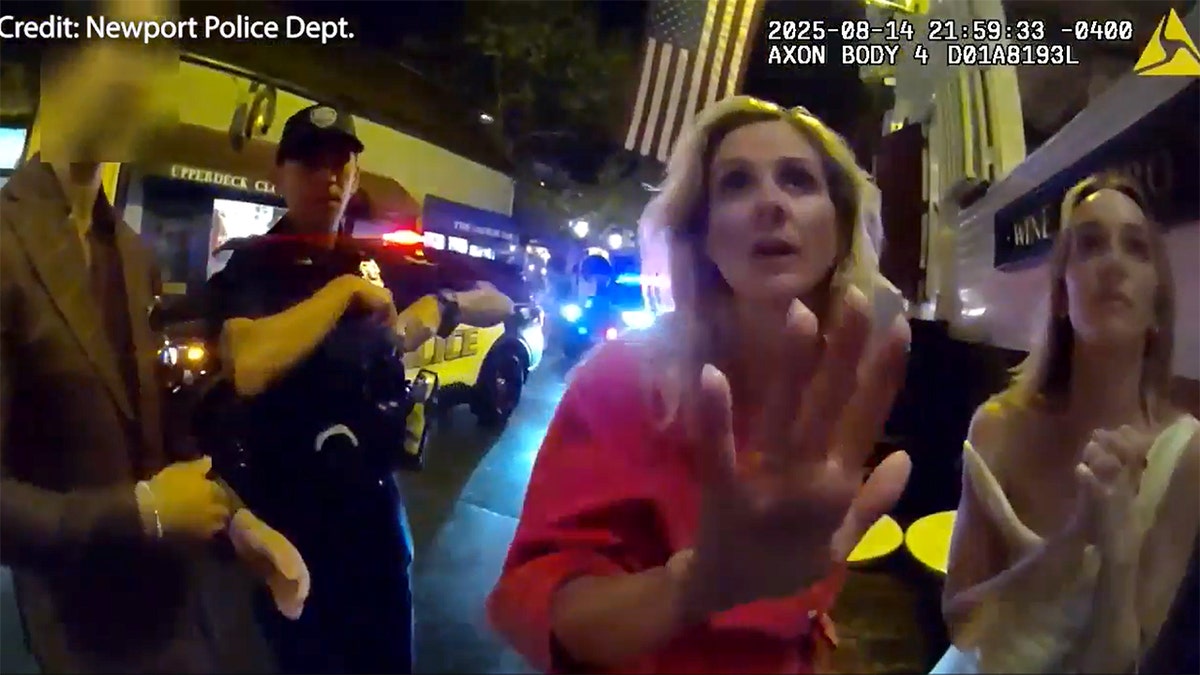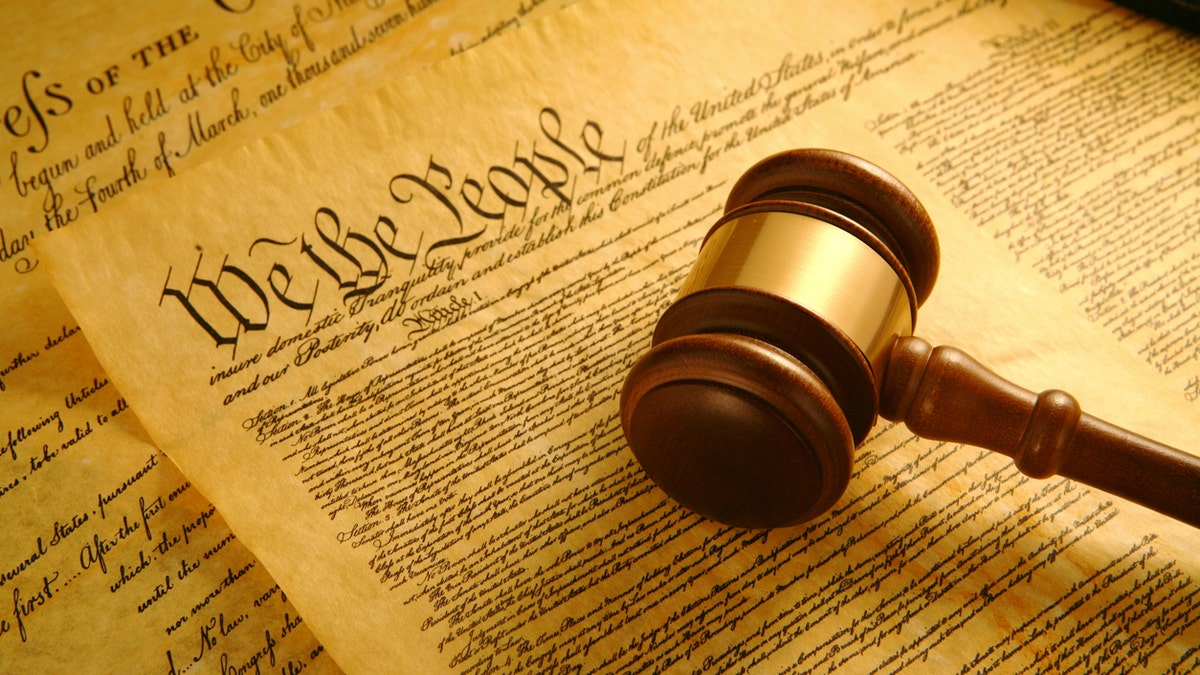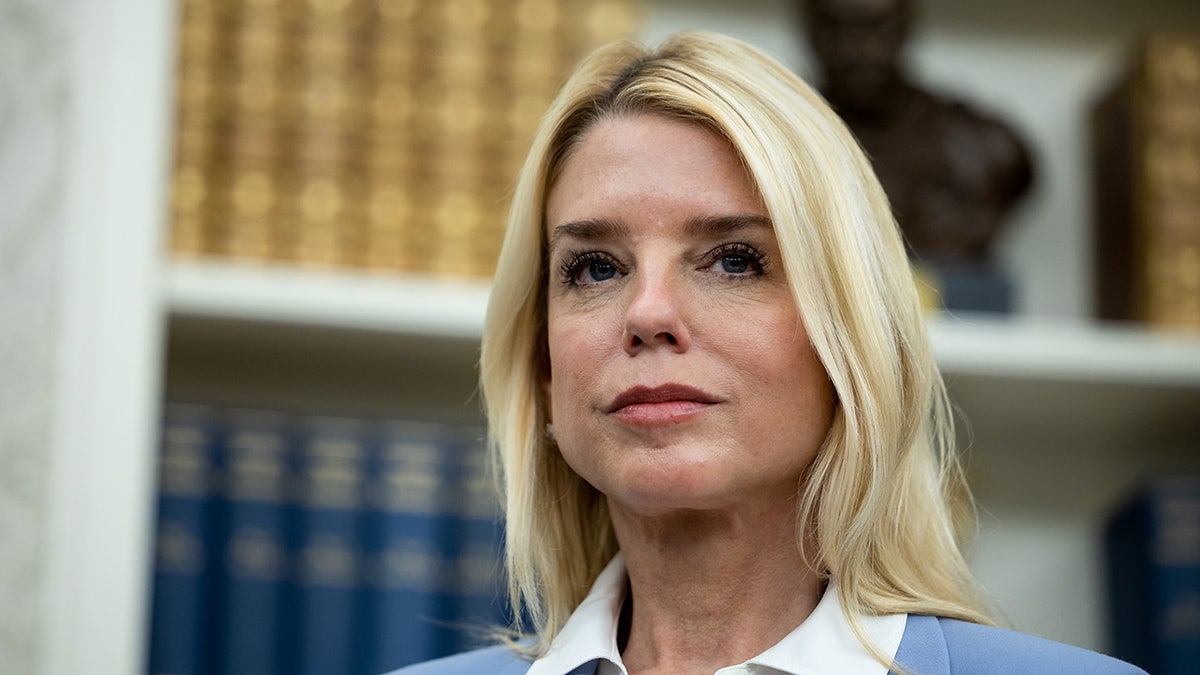INTERNACIONAL
Rhode Island prosecutor in viral arrest video placed on unpaid leave, job future unclear

NEWYou can now listen to Fox News articles!
The Rhode Island assistant attorney general, whose arrest went viral earlier this week after she seemingly tried to use her position to evade arrest, telling officers they’d «regret» putting her behind bars, will be placed on unpaid leave.
Special Assistant Attorney General Devon Flanagan, who was arrested for trespassing, was placed on paid leave directly after the incident while the Rhode Island Attorney General’s office reviewed the matter. But, starting Monday, Flanagan will go on unpaid leave, the office told Fox News Digital.
It is unclear how long Flanagan will remain on unpaid leave until a final determination is made on her employment. The Attorney General’s office did not respond to additional questions about its ongoing review of the matter, or when it might make a final decision.
FORMER TOP ADAMS ADVISOR, DONORS CHARGED IN BRIBERY CASE; CUOMO MOCKS WITH POTATO CHIP STUNT
Bodycam footage shows the arrest of a Rhode Island prosecutor, Devon Flanagan, who berated officers and yelled at them, ‘I’m an AG! I’m an AG!’ in an apparent attempt to skirt the trouble she was facing. (Newport Police Department)
State payroll records, according to the Boston Globe, show that Flanagan was raking in approximately $113,000 a year in her position as a Special Assistant Attorney General.
«I’m an AG! I’m an AG!» Flanagan could be heard saying to police as they tried to detain her for failing to comply with their demands. «You’re going to regret this. You’re going to regret it. I’m an A-» Flanagan said as she was escorted to the back of a police car and the door was shut.
«Good for you, I don’t give a s—,» one of the arresting officers can be heard saying back at one point.
CONTROVERSIAL NEW ORLEANS MAYOR INDICTED FOR ALLEGED ILLICIT RELATIONSHIP WITH TAXPAYER-FUNDED BODYGUARD
In a subsequent radio interview following Flanagan’s arrest, Rhode Island Attorney General Peter Neronha called the incident «inexcusable behavior» that will likely result in «strong, strong sanction[s].» However, he did note that this isn’t the first time he’s dealt with a case like this involving his staff.
«I’ve got 110 lawyers, she embarrassed all of them. I haven’t had many issues like this while I’ve been attorney general. I’ve had a few, and I let one guy go for driving drunk – had to bring him back – well I didn’t have to, but did bring him back after I fired him about a year later because, again, I needed somebody to go into a courtroom and try ugly, hard murder cases,» Neronha told WPRO Radio.

Rhode Island Attorney General Peter Neronha called Flanagan’s behavior «inexcusable,» but said he previously brought back a former attorney who was once arrested for drunk driving. (Lane Turner/The Boston Globe via Getty Images)
«It’s just really hard to find and keep capable lawyers and so I just have to think really carefully about this one. But no question there will be a strong, strong sanction here,» the attorney general continued.
Neronha added that he believed the incident was alcohol-related, and noted that doesn’t necessarily excuse the behavior. He also said Flanagan had an «unblemished» record working under him, is thought highly of by the state bar association and is taking steps to make amends with the New Port Police Department, including issuing an apology.
CLICK HERE TO GET THE FOX NEWS APP

A screenshot from Newport Police Department bodycam footage shows Rhode Island prosecutor Devon Flanagan arguing with police. (Newport Police Department)
The attorney general was asked about certain details of the incident, including whether Flanagan was right in telling the officer it was the law that he must turn off his body camera upon request by a citizen.
«I’m not sure what she was thinking. Clearly, she was not thinking straight,» said Neronha, who added that Flanagan was incorrect in her assertion that police officers must shut off their bodycam upon request.
«She’s humiliated herself,» Neronha added. «Regardless of what happens vis a vis her employment with us, she’s going to have a long time coming back from this. It’s just really unfortunate.»
rhode island,crime world,corruption,corruption crime,politics,police and law enforcement
INTERNACIONAL
Trump flag burning executive order could flip First Amendment on its head with new court

NEWYou can now listen to Fox News articles!
President Donald Trump and his administration are likely set to challenge a Supreme Court ruling that protected the burning of the American flag under the First Amendment with a new executive order calling for those who desecrate the U.S. flag while inciting violence or breaking other laws to face prosecution.
The executive order, which Trump signed Monday morning, directs the attorney general to prosecute those who violate laws «in ways that involve desecrating the flag,» and to pursue litigation that would clarify the scope of the First Amendment as it relates to flag desecration.
Burning the American flag, however, already has been litigated, with the Supreme Court ruling in 1989 that burning the flag is a form of symbolic speech that is protected by the First Amendment.
«I think what the president is saying, is that he’s ordering Attorney General Pam Bondi, Justice Department lawyers to prosecute those who maliciously burn an American flag,» senior legal fellow at the Heritage Foundation’s Edwin Meese III Center for Legal and Judicial Studies told Fox News Digital Monday. «And what that would essentially do is tee up a challenge eventually for the Supreme Court to revisit and potentially overturn its prior precedent saying that burning an American flag is protected speech.»
TRUMP TO CRACK DOWN ON FLAG BURNING, DESECRATION WITH EXECUTIVE ORDER
President Donald Trump signed an executive order Aug. 25, 2025, cracking down on suspects who desecrate the American flag. (Getty Images)
The 1989 case was centered on political protester Gregory Lee Johnson, who burned the American flag in 1984 outside the Republican National Convention in Dallas in protest of President Ronald Reagan’s re-election.
«America, the red, white, and blue, we spit on you,» protesters chanted as Johnson lit the flag on fire, according to details in the case, called Texas v. Johnson.
Johnson was charged under the Texas Venerated Objects Statute, a state law that prevented individuals from vandalizing respected objects such as the U.S. flag. Johnson was found guilty in 1985 and sentenced to one year behind bars and a $2,000 fine, but appealed the ruling.
The Supreme Court agreed to hear the case in 1989, with the nation’s highest court ruling in a 5–4 decision that burning the American flag was protected speech under the First Amendment. The Supreme Court held a conservative majority at the time.
TRUMP’S RENEWED CALLS TO JAIL AMERICAN FLAG BURNERS CLASHES WITH COURT PRECEDENT
Justice William J. Brennan, a Democrat nominated by former President Dwight Eisenhower, issued the majority opinion, and argued «that the government may not prohibit the expression of an idea simply because society finds the idea itself offensive or disagreeable.»
«We can imagine no more appropriate response to burning a flag than waving one’s own, no better way to counter a flag-burner’s message than by saluting the flag that burns, no surer means of preserving the dignity even of the flag that burned than by — as one witness here did — according its remains a respectful burial,» the majority opinion read. «We do not consecrate the flag by punishing its desecration, for in doing so we dilute the freedom that this cherished emblem represent.»

President Trump’s American flag executive order calls on the attorney general to use «the maximum extent permitted by the Constitution» to «vigorously prosecute those who violate our laws in ways that involve desecrating the American Flag.» (spxChrome)
Justices Thurgood Marshall, Harry A. Blackmun, Antonin Scalia and Anthony M. Kennedy joined Brennan in the majority opinion. Chief Justice Rehnquist authored the court’s dissenting opinion, arguing that the American flag holds a unique status in the U.S. that should protect it from acts such as burning.
In 1990, the Supreme Court reaffirmed its ruling the year prior, while invalidating Congress’ Flag Protection Act of 1989, which lawmakers passed in response to the Supreme Court’s Texas v. Johnson ruling.
Trump’s Monday executive order calls on the attorney general specifically to launch legal efforts to clarify «the scope of the First Amendment.»
TRUMP VOWS CONSEQUENCES FOR ‘ANIMALS’ BURNING AMERICAN FLAGS IN LA, SLAMS THOSE WAVING OTHER COUNTRIES’ FLAGS
The executive order states: «To the maximum extent permitted by the Constitution, the Attorney General shall vigorously prosecute those who violate our laws in ways that involve desecrating the American Flag, and may pursue litigation to clarify the scope of the First Amendment exceptions in this area.»
Back in 2003, current Justice Clarence Thomas provided some insight into where he stands with the burning of venerated objects, offering a dissenting opinion in the case Virginia v. Black on the burning of crosses.
Thomas cited Rehnquist’s dissenting opinion in the Texas v. Johnson case in his 2003 dissenting opinion on cross-burning.
«In every culture, certain things acquire meaning well beyond what outsiders can comprehend. That goes for both the sacred, see Texas v. Johnson, 491 U. S. 397, 422-429 (1989) (REHNQUIST, C. J., dissenting) (describing the unique position of the American flag in our Nation’s 200 years of history), and the profane. I believe that cross burning is the paradigmatic example of the latter,» he wrote in 2003.

President Trump’s executive order on flag desecration calls on the attorney general, Pam Bondi, to launch legal efforts to clarify «the scope of the First Amendment.» (Francis Chung/Politico/Bloomberg via Getty Images)
Smith pointed to two dynamics to watch out for with regard to a potential flag-burning case landing on Supreme Court’s docket in the future: that some justices have expressed «some concern that potentially expressive conduct has been read too broadly,» and how the justices will apply stare decisis, which is legal doctrine outlining courts should follow established precedents, such as the 1989 ruling.
«I think a couple of things are happening here,» he said. «I think some justices have expressed some concern that potentially expressive conduct has been read too broadly. Things that are really conduct, not speech, have been read to be protected, and maybe they should not be protected, as protected as they have been in the past.»
TRUMP SIGNS EXECUTIVE ORDERS TO ELIMINATE NO-CASH BAIL FOR SUSPECTS IN DC AND NATIONWIDE
«The other interesting dynamic, I think that you should watch for, is how certain justices will apply what’s known as stare decisis, and essentially that’s the fancy Latin term. It means that ‘they decided,’» Smith continued. «Several times recently, Chief Justice Roberts in particular, has said that even though he disagrees on the merits with the … decision the Supreme Court is reaching, he has joined the majority anyway because he believes stare decisis should apply and the court should not overturn or revisit its previous decisions in this area. Even though he may subsequently disagree with it.»
Trump celebrated the executive order during the Monday signing ceremony in the Oval Office, saying the 1989 Supreme Court ruling protecting flag burning was made by a «very sad court.»
«Flag burning. All over the country, they’re burning flags. All over the world, they burn the American flag,» he said. «And as you know, through a very sad court, I guess there was a 5 to 4 decision. They called it freedom of speech.»

President Donald Trump lamented how U.S. flags have been burned by protests on U.S. soil and abroad. (Mark Schiefelbein/The Associated Press)
«But there’s another reason, which is perhaps much more important,» he said. «It’s called death. Because what happens when you burn a flag is the area goes crazy. If you have hundreds of people, they go crazy.»
«You could do other things. You can burn this piece of paper,» he said. «But when you burn the American flag, it incites riots at levels that we’ve never seen before.»
First Amendment groups such as the Foundation for Individual Rights and Expression slammed the executive order in comment provided to Fox News Digital, saying Trump does not have the «power to revise the First Amendment with the stroke of a pen.»
«Flag burning as a form of political protest is protected by the First Amendment,» Foundation for Individual Rights and Expression Chief Counsel Bob Corn-Revere said in Monday comment. «That’s nothing new. While people can be prosecuted for burning anything in a place they aren’t allowed to set fires, the government can’t prosecute protected expressive activity — even if many Americans, including the president, find it «uniquely offensive and provocative.»
CLICK HERE TO GET THE FOX NEWS APP
«You don’t have to like flag burning,» he added. «You can condemn it, debate it, or hoist your own flag even higher. The beauty of free speech is that you get to express your opinions, even if others don’t like what you have to say,.»
white house,first amendment,donald trump,supreme court
INTERNACIONAL
El sorprendente ecosistema que late en una gota del océano

Para comprender verdaderamente el cosmos microscópico que exploraremos, primero debemos visualizar qué son exactamente 50 microlitros. Esta cantidad, equivalente a una gota típica de agua marina, representa apenas la mitad de una décima de mililitro. Para hacernos una idea, 20 000 gotas de este tamaño serían un litro de líquido o el equivalente a unas 100 cucharadas.
En términos cotidianos, es 10 veces menor que el volumen de un grano de arroz y equivale aproximadamente al volumen de un cabello humano de un centímetro de largo. Esta diminuta cantidad puede parecer insignificante, pero cuando se trata de una gota de agua de mar, representa un universo repleto de vida.
Las aguas costeras de Galicia, especialmente en zonas como la ría de Vigo, albergan una biodiversidad microscópica extraordinaria. En una sola gota de estas aguas podríamos encontrar entre 50 000 y 100 000 bacterias y una cantidad incluso mayor de virus. Pero estos números apenas comienzan a describir la complejidad de este mundo invisible.
Los estudios realizados en las costas gallegas han revelado que los organismos microscópicos más diversos son los protistas, es decir, los animales, plantas u hongos cuyas células contienen un núcleo celular definido (eucariotas). Individualmente más grandes que las bacterias, están presentes en números menores, pero con una diversidad extraordinaria: representan casi la mitad de toda la vida microscópica presente en estas aguas.
Los virus marinos son probablemente los habitantes más numerosos de nuestra gota oceánica gallega. En nuestros diminutos 50 microlitros, podríamos encontrar entre 50 000 y 500 000 partículas virales.
Aunque son invisibles incluso con los mejores microscopios ópticos, estos virus desempeñan un papel crucial controlando las poblaciones de bacterias y otros microorganismos. Sin embargo, curiosamente, los estudios en mejillones de las rías gallegas muestran que estos bivalvos filtradores apenas retienen virus en sus tejidos, lo que sugiere que los estos agentes microscópicos permanecen principalmente en la columna de agua.
Las bacterias marinas son las verdaderas trabajadoras de nuestro océano. En cada gota, encontraríamos representantes de los principales grupos que mantienen funcionando los ecosistemas marinos. Los tipos más comunes en las aguas gallegas pertenecen a grupos como oceanospirillales, flavobacteriales y vibrionales.
Estas bacterias realizan tareas esenciales: reciclan nutrientes, producen oxígeno, descomponen materia orgánica y participan en los ciclos del carbono y nitrógeno que mantienen saludable el ecosistema marino. Algunas viven flotando libremente en el agua, mientras otras forman comunidades adheridas a partículas o superficies.
Los protistas son, quizás, los habitantes más fascinantes de nuestra gota gallega. Este grupo incluye las diatomeas, que son como pequeñas joyas microscópicas con caparazones de cristal y producen gran parte del oxígeno que respiramos.
En las aguas de las rías gallegas, abundan especialmente las diatomeas como Navicula, Amphora y Pseudo-nitzschia. Esta última puede producir toxinas que ocasionalmente afectan a los mejillones cultivados en las bateas gallegas.
También encontraríamos dinoflagelados –microorganismos unicelulares que forman parte del fitoplancton–, algunos de los cuales pueden crear las famosas “mareas rojas” cuando se multiplican masivamente.
Ciertos dinoflagelados poseen una característica especial que los convierte en verdaderos artistas de la naturaleza: la bioluminiscencia. Cuando son perturbados por el movimiento del agua, emiten una luz azul verdosa que crea uno de los espectáculos más mágicos de nuestras costas: el famoso “mar de ardora” gallego. En noches especialmente cálidas de verano, millones de estos organismos microscópicos pueden iluminar las olas que rompen en nuestras playas, convirtiendo el mar en un verdadero universo de estrellas líquidas. En nuestra pequeña gota de 50 microlitros podríamos tener cientos de estos organismos bioluminiscentes esperando brillar al menor movimiento.
Otros inquilinos de nuestras gotas son unos depredadores microscópicos llamados ciliados, que controlan las poblaciones bacterianas como verdaderos “lobos” microscópicos.
Hongos marinos, recicladores especializados
Aunque menos abundantes que otros grupos, los hongos son cruciales para la descomposición en nuestras aguas gallegas. En nuestros 50 microlitros encontraríamos entre 1 000 y 5 000 esporas fúngicas o estructuras reproductivas.
Estos hongos incluyen especies que pueden afectar a los organismos marinos cultivados en Galicia. Algunos géneros como Aplanochytrium y Thraustochytrium pueden causar enfermedades en crustáceos y otros invertebrados marinos, lo que los convierte en organismos de especial interés para los acuicultores gallegos.
Protozoos, grandes tragones
Nuestra gota gallega también alberga larvas de muchos de los invertebrados marinos que conocemos en forma adulta, como percebes, mejillones, cangrejos y peces. También encontraríamos rotíferos, copépodos juveniles y otros diminutos organismos.
Durante el verano, cuando las aguas están más cálidas, son más abundantes. En nuestros diminutos 50 microlitros podríamos encontrar entre 5 y 50 de estos metazoos microscópicos, dependiendo de la estación del año y la ubicación específica en la ría.
Nuestro conocimiento de este universo microscópico se debe a técnicas modernas de análisis genético. Los científicos ya no necesitan cultivar estos organismos en laboratorio, algo que era imposible para la mayoría. Ahora pueden extraer todo el material genético de una muestra de agua y analizar las huellas dactilares genéticas de cada organismo presente.
Esta tecnología, llamada metabarcoding de ADN, permite identificar miles de especies simultáneamente. Es como hacer un censo completo de todos los habitantes microscópicos de una gota de agua en una sola operación.
Más allá de los números, lo verdaderamente fascinante de esta gota oceánica son las intrincadas relaciones entre los organismos que la habitan: los virus infectan bacterias y otros microorganismos, controlando sus poblaciones; las bacterias reciclan nutrientes que luego utilizan las diatomeas y otros productores microscópicos; los ciliados y otros protistas se alimentan de bacterias, y los hongos descomponen materia orgánica compleja.
Todos estos procesos ecológicos ocurren simultáneamente en el espacio microscópico de una gota, como un ecosistema completo, con sus productores, consumidores y descomponedores.
La próxima vez que pasee por la playa, recuerde que cada gota, cada diminuta fracción de 50 microlitros, contiene más diversidad biológica que muchos bosques enteros. En este universo microscópico se desarrollan historias de supervivencia, competencia y cooperación, ciclos de vida completos y procesos que son fundamentales para mantener la salud de nuestras rías y la productividad pesquera y marisquera que caracteriza a Galicia.
Artículo prublicado originalmente en The Conversation
INTERNACIONAL
Evergrande: este es el fin de la otrora más poderosa empresa inmobiliaria de China

El momento pasó sin pena ni gloria. China Evergrande, una promotora inmobiliaria que alguna vez representó la cumbre del poderío económico de China, fue formalmente eliminada de la Bolsa de Hong Kong el lunes.
Evergrande, que hizo su debut financiero en Hong Kong hace 16 años, había sido en un momento la promotora inmobiliaria de más rápido crecimiento en un país rebosante de promesas de ganancias para los inversores. Será recordada como una de las empresas más endeudadas del mundo, cuyo colapso llevó al sistema financiero de China al límite.
La empresa puso a prueba la antigua política de Beijing de «demasiado grande para quebrar» hacia sus compañías más grandes. Rompió su tolerancia al endeudamiento descontrolado por parte de corporaciones gigantes. Y el colapso de Evergrande en 2021, con más de $300 mil millones en deuda, expuso las vulnerabilidades de la economía de China y su dependencia del sector inmobiliario como motor de crecimiento.
Ahora lo que queda es el esqueleto de un gigante corporativo: 1.300 proyectos inmobiliarios aún sin terminar en más de 280 ciudades y cientos de miles de compradores de viviendas que siguen esperando sus departamentos.
Luego está la larga fila de acreedores, desde empresas en China que trabajaban para Evergrande hasta inversores en Londres y Nueva York que apostaron por ella, que aún esperan ser reembolsados.
El año pasado, un juez de Hong Kong ordenó que Evergrande fuera desmantelada. Designó a Alvarez & Marsal, una firma que se especializa en quiebras y que una vez ayudó a disolver a Lehman Brothers, para que se encargara de la tarea.
Un año y medio después de comenzar el trabajo, los liquidadores, dos ejecutivos de Alvarez & Marsal, han dado pequeños pasos para ayudar a los acreedores extranjeros a obtener pequeñas porciones de lo que se les debe.
Los últimos documentos divulgados públicamente por Evergrande demuestran los desafíos.
Los acreedores han realizado cientos de acciones legales contra los proyectos de Evergrande en China y docenas de activos han sido congelados. En algunos casos, los inversores o los gobiernos locales se han hecho cargo de las promociones. Ya es difícil para los liquidadores de Hong Kong recuperar activos para otros acreedores debido a la compleja estructura empresarial de Evergrande con miles de filiales.
Para extraer dinero de lo que queda de Evergrande, los liquidadores tienen que hacerse cargo de cada filial una por una. Alvarez & Marsal ha tomado hasta ahora el control de más de 100 empresas y activos por un valor de alrededor de $3.5 mil millones.
Pero solo se han conseguido alrededor de $255 millones de los $45 mil millones que los acreedores en Hong Kong afirman que se les debe. Y los liquidadores han advertido que incluso el valor de algunos de los activos incautados está en duda, lo que genera «serias dudas sobre las cantidades, si las hay, que en última instancia se puedan obtener en beneficio de los acreedores de la empresa».
Los liquidadores están siguiendo otra vía legal para tratar de extraer dinero de Evergrande: ir tras el expresidente, Hui Ka Yan, su esposa, Ding Yu Mei, y el ex director ejecutivo de Evergrande, Xia Haijun.
Un caso que tiene lugar en Hong Kong, con audiencias a puerta cerrada, ha puesto en la mira activos por valor de $6 mil millones que Hui y otros ejecutivos se pagaron a sí mismos en los años posteriores a la salida a bolsa de Evergrande en Hong Kong.
Es un estudio del exceso de una época pasada en la que la industria inmobiliaria china era más libre. Hasta ahora, el caso se ha centrado principalmente en la esposa de Hui y en Xia. Hui fue detenido en 2023 y las autoridades lo han multado desde entonces con $6.5 millones y lo han acusado de «organizar un fraude».
Una presentación judicial reciente afirmó que Xia, quien fue multado con $2 millones y vetado de los mercados financieros por un importante regulador chino por fraude de valores, está ocultando activos por valor de $24 millones en varias casas y coches de lujo en California.
Una de esas propiedades, en Irvine, tiene un valor de $6.3 millones y fue comprada en abril de 2022, un mes después de que Evergrande retrasara repentinamente sus resultados anuales de 2021 y dijera que los bancos habían incautado préstamos por valor de $2 mil millones, según muestran los documentos judiciales. Varios meses después, Xia renunció por lo que la empresa dijo que había sido un plan para desviar $2 mil millones a una de sus empresas cotizadas en Hong Kong desde una filial.
Apenas unos meses antes de que Xia fuera multado en marzo de 2024, su esposa gastó $14.5 millones en una enorme mansión en Newport Beach, California, según los documentos judiciales. Él ha declarado ante el tribunal que no posee nada que valga más de $6.400.
c.2025 The New York Times Company

 DEPORTE2 días ago
DEPORTE2 días agoChile organizó una colecta para que la familia del hincha que fue operado por fractura de cráneo pueda viajar a la Argentina

 CHIMENTOS3 días ago
CHIMENTOS3 días agoConfirmado: Susana Giménez vuelve con un programa de los más esperados

 DEPORTE2 días ago
DEPORTE2 días agoEl fútbol chileno se solidarizó con la U tras los graves incidentes que se registraron ante Independiente

























